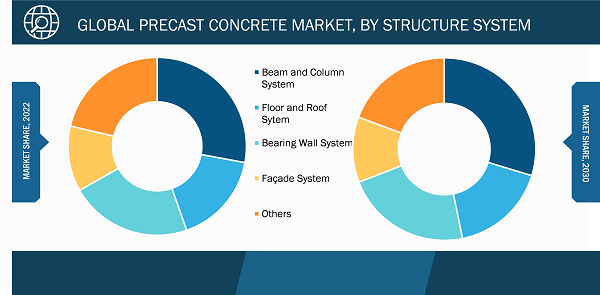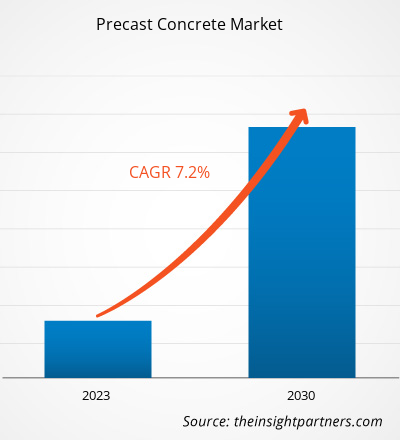2022 年预制混凝土市场规模价值 1509.3 亿美元,预计到 2030 年将达到 2637.1 亿美元;预计 2022 年至 2030 年的复合年增长率为 7.2%。
市场分析
预制混凝土是一种建筑材料,通过在可重复使用或可模塑的框架中浇铸混凝土,然后在受控环境中固化而制成。此类材料在制造时预制和预制,然后在施工现场组装和模塑。此类结构能够提高施工速度、提高生产率和质量,同时具有成本效益。因此,随着对经济高效和安全材料的需求不断增长,对预制混凝土的需求预计会增加。这种形式的结构被归类为可持续建筑材料,因为它们可以大量重复使用或重塑,从而减少对环境的影响。绿色和模块化建筑材料的日益普及预计将增加全球市场对预制混凝土产品的需求。
增长动力与挑战
预制技术通常与性能、保护和耐用性相关,所有这些都是优于传统建筑方法的优势。除了这些优势之外,预制件的一个重要特征是它有潜力降低建筑成本,并在项目前、中、后节省大量成本。与传统建筑构件中使用的其他材料不同,预制构件通常由当地可用的天然原材料制成,如水泥、石头、沙子和砾石。它可以重复使用或完全回收,这有助于减少原材料在其生命周期内对环境的影响。此外,主要关注的是推广安全和数字化施工,以减少工地的死亡人数。例如,几起报告的事故表明,在使用夹具提升空心板时造成了死亡。在施工过程中使用预制构件可以确保施工现场的安全和保护。
预制混凝土也是办公楼的流行建筑材料。建筑墙体可以在现场建造地基的同时制造,从而节省时间并确保尽早入住。由于预制结构建造速度快、容易,预制件已广受欢迎,成为停车场建筑的首选建筑材料。预制混凝土可在所有天气条件下安全、经济高效地施工。它还提供停车场所需的长净跨度和开放空间。此外,预制混凝土节省时间和金钱,并且比现场混凝土施工具有更高的质量控制。预制混凝土施工与现浇混凝土结构以及钢、木材和砖石结构相比具有许多优势,例如环保、抗震和节能。它允许更快、更可靠的施工过程。对经济高效、安全和环保产品的日益关注预计将刺激全球预制混凝土市场的增长
定制研究以满足您的需求
我们可以优化和定制标准产品无法满足的分析和范围。这种灵活性将帮助您获得业务规划和决策所需的准确信息。
预制混凝土市场:

复合年增长率(2022 - 2030 年)7.2%- 2022 年市场规模
1509.3 亿美元 - 2030 年市场规模
2637.1 亿美元

市场动态
- 需要经济高效、安全环保的产品
- 全球范围内翻修和改造活动增多
- 对创新和产品开发进行大量投资
- 新兴经济体政府的支持举措
关键人物;主力;重要一员
- CRH集团
- 海德堡材料股份公司
- Cemex SAB de CV 制造商
- 霍尔希姆有限公司
- 康索利斯集团
- Elementbau Osthessen GmbH & Co.,ELO KG
- 福特拉公司
- Centrum Pile 有限公司
- 巴尔弗贝蒂公司
区域概况

- 北美
- 欧洲
- 亚太
- 南美洲和中美洲
- 中东和非洲
市场细分
 结构体系
结构体系- 梁柱体系
- 地板和屋顶系统
- 承重墙系统
- 立面系统
- 其他的
 最终用途
最终用途- 住宅
- 商业的
- 其他的
- 示例 PDF 通过定性和定量分析展示了内容结构和信息的性质。
报告分类和范围
“2030 年全球预制混凝土市场预测”是一项专业而深入的研究,主要关注全球预制混凝土市场的趋势和机遇。该报告旨在提供市场概况,并根据结构系统、最终用途和地理位置对市场进行详细细分。全球预制混凝土市场近年来一直保持高增长,预计在预测期内将继续保持这一趋势。该报告提供了全球预制混凝土使用情况的关键统计数据以及主要地区和国家的需求。此外,它还对影响主要地区和国家预制混凝土市场表现的各种因素进行了定性评估。该报告还包括对主要市场参与者及其关键战略发展的全面分析。还包括对市场动态的几项分析,以帮助确定关键驱动因素、市场趋势和有利可图的预制混凝土市场机会,进而有助于确定主要收入来源。
此外,生态系统分析和波特五力分析提供了全球预制混凝土市场的360度视角,有助于了解整个供应链和影响市场增长的各种因素。
- 示例 PDF 通过定性和定量分析展示了内容结构和信息的性质。
节段分析
全球预制混凝土市场根据结构系统和最终用途进行分类。就结构系统而言,市场分为梁柱系统、楼板和屋顶系统、承重墙系统、外墙系统等。根据最终用途,市场分为住宅、商业和其他。
根据结构系统,梁柱系统部分在 2022 年占据了全球预制混凝土市场的很大份额。梁是形成三种基本形状之一的结构部件,包括矩形、倒置 T 形梁和 L 形梁。梁主要用于支撑桥面构件,例如实心板、双 T 形梁、空心梁,有时还有其他梁。按最终用途,商业部门在 2022 年以最大的市场份额引领全球预制混凝土市场。商业部门包括体育设施、学校、学院、政府机构、医院、学校、办公室和其他商业空间。预制混凝土用于全球体育设施的建设。预制体育专用组件使总承包商和建筑师能够灵活地实现创新和复杂的设计,并最大化座位。


- 示例 PDF 通过定性和定量分析展示了内容结构和信息的性质。
区域分析
该报告详细概述了全球预制混凝土市场,涉及五个主要地区——北美、欧洲、亚太地区 (APAC)、中东和非洲 (MEA) 以及南美和中美洲。亚太地区占全球预制混凝土市场份额的很大一部分,2022 年的价值约为 750 亿美元。亚太地区的预制混凝土市场分为澳大利亚、中国、印度、日本、韩国和亚太其他地区。中国是该地区市场增长的主要贡献者。十多年来,中国一直是规模最大、增长最快的建筑业。预计欧洲也将出现显着增长,到 2030 年将达到 450 亿美元以上。此外,在北美,预制混凝土的使用非常广泛。这为预制混凝土市场创造了丰厚的机会。预计从 2022 年到 2030 年,北美预制混凝土市场的复合年增长率将达到约 7%。
行业发展和未来机遇
合作、收购和新产品发布是全球预制混凝土市场参与者采用的一些突出策略。
- 2023 年 8 月,Cemex SAB de CV 收购了马德里附近的两座采石场。通过此次收购,该公司能够更好地为该地区的客户提供服务,尤其是基础设施行业的客户。
- 2023 年 5 月,Holcim Ltd. 收购了 Besblock Ltd,后者是英国中部地区建筑行业领先的预制材料供应商。Besblock 技术平台致力于生产可持续建筑砌块,年产能约为 250 万平方米。
- 2022 年 3 月,Holcim 收购了预制混凝土产品和服务制造商 HM Factory,净销售额为 1.9698 亿美元。其解决方案涵盖各种需求,例如墙壁、楼梯和阳台。HM Factory 处于理想位置,可以利用工业和住宅建筑的增长。
新冠肺炎疫情的影响
在新冠疫情爆发之前,全球建筑业正在迅速扩张。政府启动了雄心勃勃的基础设施项目,包括建设新城市、交通网络和娱乐综合体。这种增长推动了各种建筑应用中对预制混凝土构件的需求。
在 2020 年的 COVID-19 疫情期间,预制混凝土行业受到的影响最小。制造商和承包商采用了不同的制造方法,例如场外施工,这导致预制混凝土生产得以继续。场外施工技术使大多数预制混凝土制造商能够以 100% 的生产能力运营其工厂,严格遵守 COVID-19 规范。因此,预计预制混凝土市场将在 2022 年至 2030 年间强劲增长。
竞争格局和主要公司
Cemex SAB de CV 制造商;Holcim Ltd;Consolis Group SAS;Elementbau Osthessen GmbH & Co., ELO KG;Forterra;Centrum Pile Ltd.;Balfour Beatty Plc;CRH Plc;Heidelberg Materials AG 和 Boral 是全球预制混凝土市场中的几家主要参与者。
预制混凝土市场报告范围
| 报告属性 | 细节 |
|---|---|
| 2022 年市场规模 | 1509.3亿美元 |
| 2030 年的市场规模 | 2637.1亿美元 |
| 全球复合年增长率(2022 - 2030 年) | 7.2% |
| 历史数据 | 2020-2021 |
| 预测期 | 2023-2030 |
| 涵盖的领域 | 按结构体系
|
| 覆盖地区和国家 | 北美
|
| 市场领导者和主要公司简介 |
|
- 示例 PDF 通过定性和定量分析展示了内容结构和信息的性质。
- 历史分析(2 年)、基准年、预测(7 年)及复合年增长率
- PEST 和 SWOT 分析
- 市场规模价值/数量 - 全球、区域、国家
- 行业和竞争格局
- Excel 数据集



Report Coverage
Revenue forecast, Company Analysis, Industry landscape, Growth factors, and Trends

Segment Covered
This text is related
to segments covered.

Regional Scope
North America, Europe, Asia Pacific, Middle East & Africa, South & Central America

Country Scope
This text is related
to country scope.
常见问题
A few players operating in the global precast concrete market include Cemex SAB de CV manufacturer; Holcim Ltd; Consolis Group SAS; Elementbau Osthessen GmbH & Co., ELO KG; Forterra; Centrum Pile Ltd.; Balfour Beatty Plc; CRH Plc; Heidelberg Materials AG; and Boral.
Asia Pacific is estimated to register the fastest CAGR in the global precast concrete market over the forecast period. This is mainly attributed to an increasing use of precast concrete in different application fields such as residential, commercial, and others.
The projected growth of the market during the forecast period is attributed to rise in renovation and remodeling activities across the globe and increasing need for cost-effective, safe, and eco-friendly products.
The commercial segment held the largest share of the global precast concrete market in 2022. There is a high demand for precast concrete from the commercial sector, owing to the rising investment in commercial construction projects.
The beams and columns segment held the largest share of the global precast concrete market in 2022. Beam and columns are significantly used in residential and commercial purpose infrastructures. With the rapid rise in residential and commercial construction backed by rapid urbanization across the world, the market for beams and columns is expected to rise.
In 2022, Asia Pacific held the largest share of the global precast concrete market. The dominance of the precast concrete market in this region is primarily attributable to the presence of a strong industrial base with prominent manufactures significantly contributing to market growth.
Trends and growth analysis reports related to Chemicals and Materials : READ MORE..
The List of Companies - Precast Concrete Market
- CRH Plc
- Heidelberg Materials AG
- Cemex SAB de CV manufacturer
- Holcim Ltd
- Consolis Group SAS
- Elementbau Osthessen GmbH & Co., ELO KG
- Forterra Plc
- Centrum Pile Ltd
- Balfour Beatty Plc
- Boral
The Insight Partners performs research in 4 major stages: Data Collection & Secondary Research, Primary Research, Data Analysis and Data Triangulation & Final Review.
- Data Collection and Secondary Research:
As a market research and consulting firm operating from a decade, we have published and advised several client across the globe. First step for any study will start with an assessment of currently available data and insights from existing reports. Further, historical and current market information is collected from Investor Presentations, Annual Reports, SEC Filings, etc., and other information related to company’s performance and market positioning are gathered from Paid Databases (Factiva, Hoovers, and Reuters) and various other publications available in public domain.
Several associations trade associates, technical forums, institutes, societies and organization are accessed to gain technical as well as market related insights through their publications such as research papers, blogs and press releases related to the studies are referred to get cues about the market. Further, white papers, journals, magazines, and other news articles published in last 3 years are scrutinized and analyzed to understand the current market trends.
- Primary Research:
The primarily interview analysis comprise of data obtained from industry participants interview and answers to survey questions gathered by in-house primary team.
For primary research, interviews are conducted with industry experts/CEOs/Marketing Managers/VPs/Subject Matter Experts from both demand and supply side to get a 360-degree view of the market. The primary team conducts several interviews based on the complexity of the markets to understand the various market trends and dynamics which makes research more credible and precise.
A typical research interview fulfils the following functions:
- Provides first-hand information on the market size, market trends, growth trends, competitive landscape, and outlook
- Validates and strengthens in-house secondary research findings
- Develops the analysis team’s expertise and market understanding
Primary research involves email interactions and telephone interviews for each market, category, segment, and sub-segment across geographies. The participants who typically take part in such a process include, but are not limited to:
- Industry participants: VPs, business development managers, market intelligence managers and national sales managers
- Outside experts: Valuation experts, research analysts and key opinion leaders specializing in the electronics and semiconductor industry.
Below is the breakup of our primary respondents by company, designation, and region:

Once we receive the confirmation from primary research sources or primary respondents, we finalize the base year market estimation and forecast the data as per the macroeconomic and microeconomic factors assessed during data collection.
- Data Analysis:
Once data is validated through both secondary as well as primary respondents, we finalize the market estimations by hypothesis formulation and factor analysis at regional and country level.
- Macro-Economic Factor Analysis:
We analyse macroeconomic indicators such the gross domestic product (GDP), increase in the demand for goods and services across industries, technological advancement, regional economic growth, governmental policies, the influence of COVID-19, PEST analysis, and other aspects. This analysis aids in setting benchmarks for various nations/regions and approximating market splits. Additionally, the general trend of the aforementioned components aid in determining the market's development possibilities.
- Country Level Data:
Various factors that are especially aligned to the country are taken into account to determine the market size for a certain area and country, including the presence of vendors, such as headquarters and offices, the country's GDP, demand patterns, and industry growth. To comprehend the market dynamics for the nation, a number of growth variables, inhibitors, application areas, and current market trends are researched. The aforementioned elements aid in determining the country's overall market's growth potential.
- Company Profile:
The “Table of Contents” is formulated by listing and analyzing more than 25 - 30 companies operating in the market ecosystem across geographies. However, we profile only 10 companies as a standard practice in our syndicate reports. These 10 companies comprise leading, emerging, and regional players. Nonetheless, our analysis is not restricted to the 10 listed companies, we also analyze other companies present in the market to develop a holistic view and understand the prevailing trends. The “Company Profiles” section in the report covers key facts, business description, products & services, financial information, SWOT analysis, and key developments. The financial information presented is extracted from the annual reports and official documents of the publicly listed companies. Upon collecting the information for the sections of respective companies, we verify them via various primary sources and then compile the data in respective company profiles. The company level information helps us in deriving the base number as well as in forecasting the market size.
- Developing Base Number:
Aggregation of sales statistics (2020-2022) and macro-economic factor, and other secondary and primary research insights are utilized to arrive at base number and related market shares for 2022. The data gaps are identified in this step and relevant market data is analyzed, collected from paid primary interviews or databases. On finalizing the base year market size, forecasts are developed on the basis of macro-economic, industry and market growth factors and company level analysis.
- Data Triangulation and Final Review:
The market findings and base year market size calculations are validated from supply as well as demand side. Demand side validations are based on macro-economic factor analysis and benchmarks for respective regions and countries. In case of supply side validations, revenues of major companies are estimated (in case not available) based on industry benchmark, approximate number of employees, product portfolio, and primary interviews revenues are gathered. Further revenue from target product/service segment is assessed to avoid overshooting of market statistics. In case of heavy deviations between supply and demand side values, all thes steps are repeated to achieve synchronization.
We follow an iterative model, wherein we share our research findings with Subject Matter Experts (SME’s) and Key Opinion Leaders (KOLs) until consensus view of the market is not formulated – this model negates any drastic deviation in the opinions of experts. Only validated and universally acceptable research findings are quoted in our reports.
We have important check points that we use to validate our research findings – which we call – data triangulation, where we validate the information, we generate from secondary sources with primary interviews and then we re-validate with our internal data bases and Subject matter experts. This comprehensive model enables us to deliver high quality, reliable data in shortest possible time.

 获取此报告的免费样本
获取此报告的免费样本